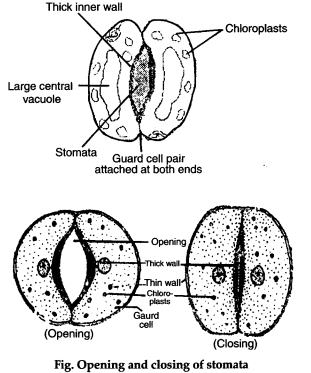Explain the structure of stomata. What role do they j play in transpiration ?
OR
What causes opening and closing of stomata during transpiration
Stomata are tiny pores present in the epidermis of leaves and other soft aerial parts of the plant. They are meant for the gaseous exchange but are also the main source of transpiration.
(a) Each stomata is surrounded by two small specialized j
epidermal cells called guard cells. j
(b) The guard cells are rapidly influenced by turgor changes and thus regulate the opening and closing of stomata.
© The walls are differently thickened. The inner wall is thick and inelastic. The remaining wall is thin and j elastic.
(d) When turgor develops in the guard cells, their outer thin walls expand outwards. This draws the inner thick walls slightly apart and create a pore between j the two guard cells. This opens the stomata.
(e) When the guard cells lose turgor, due to water loss, the inner walls regain their original shape.
(f) The guard cells become flaccid and the stoma closes.
(g) In monocot plants the guard cells are somewhat elongated dumb-bell shaped in outline.
(h) Their expanded ends are thin walled, while the middle portion is highly thick walled.
(i) In such cases, the opening and closing of the stomatal pore is caused by expansion and contraction of the thin walled ends of the guard cells
